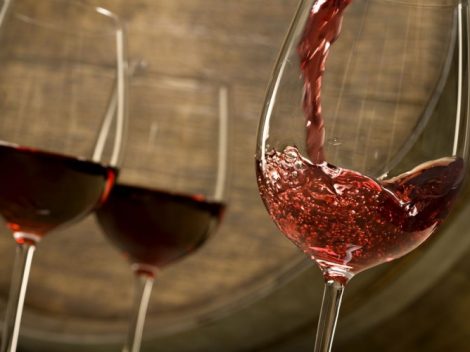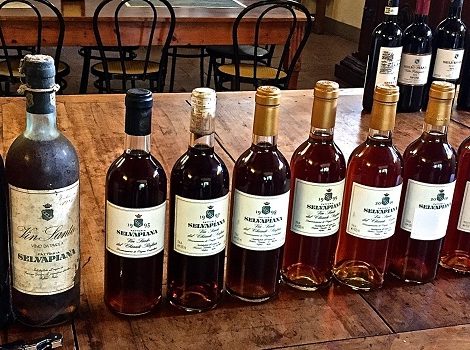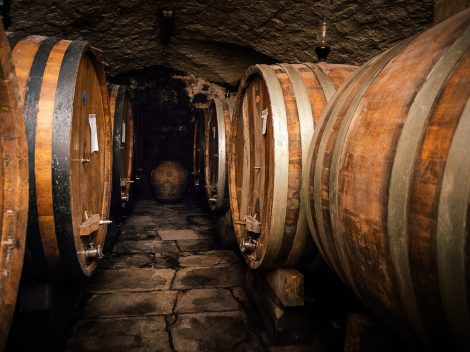Vinous
New reviews and updates by Antonio Galloni on Vinous
Antonio Galloni reviewed on Vinous the following Selvapiana wines: 2018 Chianti Rufina – 92 points 2017 Chianti Rufina – 93 points 2016 Chianti Rufina Vigneto Erchi – 95 points 2016 Chianti Rufina Vigneto Bucerchiale – 94 points 92 pts Selvapiana 2018 Chianti Rùfina Chianti Rùfina, Tuscany Red wine from Italy Drinking window: 2023 – 2038 Selvapiana’s 2018 Chianti Rufina is exquisitely beautiful. A wine of translucence and character, the 2018 captures the essence of the vintage in spades. Dark cherry, blood orange, cinnamon, rose petal and mint are all laced together in the glass. The 2018 is effortless and silky, with striking aromatic presence and exceptional balance. This is so impressive. Antonio Galloni. Tasting date: September 2020 93 pts Selvapiana 2017 Chianti Rùfina Chianti Rùfina, Tuscany Red wine from Italy Drinking window: 2023 – 2037 The 2017 Chianti Rufina is fascinating to taste next to the 2018. It is richer and more intense, yet never strays too far from its Rufina roots. Sweet red cherry/raspberry fruit, chalk, mint and white flowers are some of the aromas and flavors that start to open with a bit of time in the glass. While the 2017 offers notable fruit density and volume, the tannins also have an element of firmness that is going to require cellaring or a good bit of aeration. It is another fabulous wine from Selvapiana. Antonio Galloni. Tasting date: September 2020 95 pts Selvapiana 2016 Chianti Rùfina Vigneto Erchi Chianti Rùfina, Tuscany Red wine from Italy Drinking window: 2023 – 2041 A new wine in the range, the 2016 Chianti Rufina Vigneto Erchi is off the charts. The purest essence of Sangiovese emerges from a wine that combines power with translucent finesse. Bright acids and citrus accents perk up the red Sangiovese fruit. Initially a bit austere, the 2016 gains volume with time in the glass. The Erchi emerges from a relatively new parcel for the state planted with cuttings from Bucerchiale. Compared to that wine, the Erchi has a much more red-fruited profile and also appears to handle aging in French oak better. The 2016 is a stellar debut. Don’t miss it. Antonio Galloni. Tasting date: September 2020 94 pts Selvapiana 2016 Chianti Rùfina Vigneto Bucerchiale Chianti Rùfina, Tuscany Red wine from Italy Drinking window: 2026 – 2041 The 2016 Chianti Rufina Vigneto Bucerchiale is a dark, brooding wine. Swaths of tannin make a first impression. Gradually, black cherry, plum, lavender, cloves, leather and menthol start to emerge. This potent, massively tannic Chianti Rufina is going to need a number of years to come around. There is plenty of depth, but the elements are totally put together. The 2016 finishes with tremendous substance and gravitas. I expect the 2016 will always remain a brute. Antonio Galloni. Tasting date: September 2020
New reviews by Antonio Galloni on Vinous
Antonio Galloni reviewed on Vinous the following Selvapiana wines: 2016 Chianti Rufina Vigneto Erchi – 91 + punti 2016 Chianti Rufina Vigneto Bucerchiale – 93 + punti 91+ pts Selvapiana 2016 Chianti Rùfina Vigneto Erchi Chianti Rùfina, Tuscany Red wine from Italy Drinking window: 2023 - 2031 The 2016 Chianti Rùfina Vigneto Erchi is powerful, earthy and savory. There is plenty of power and structure, but not a lot of fruit, while the tannins are searing. This is an especially severe style, even within the realm of Rùfina. Macerated red cherry, iron, dried herbs, chalk, mint and white pepper open up in the glass, but only with great reluctance. It will be interesting to see if the 2016 opens up with time. Today, it is quite unyielding. Antonio Galloni. Tasting date: July 2019 From 2016 Chianti Classico – A Modern Day Benchmark (Aug 2019) Selvapiana Grape/Blend Sangiovese Release price Not Available Cases Produced (12 bottles/case) 250 Release Date May 2019 Winery/Importer Contact Info selvapiana.it. 93+ pts Selvapiana 2016 Chianti Rùfina Vigneto Bucerchiale Chianti Rùfina, Tuscany Red wine from Italy Drinking window: 2022 - 2036 The 2016 Chianti Rùfina Vigneto Bucerchiale is a real standout. A wine of vertical explosiveness and energy, the 2016 Bucerchiale is deep, wonderfully defined and full of nuance. Macerated cherry, kirsch, sweet tobacco, licorice, menthol, chocolate and spice abound in this super-expressive, nuanced Chianti Rùfina. Expressive savory notes add the closing shades of nuance. This is a such a gorgeous and complete wine. Antonio Galloni. Tasting date: July 2019 From 2016 Chianti Classico – A Modern Day Benchmark (Aug 2019) Selvapiana Grape/Blend Sangiovese Release price Not Available Cases Produced (12 bottles/case) 3000 Release Date February 2020 Winery/Importer Contact Info selvapiana.it.
Bryce Wiatrak featured Selvapiana in his Vin Santo article for Vinous Media
Bryce Wiatrak featured Selvapiana in his Vin Santo article for Vinous Media. Selvapiana The furthest north I traveled in my exploration of Vin Santo was to Chianti Rùfina to visit Federico Giuntini at Selvapiana. I can hardly characterize an entire sub-region based solely on one producer, nonetheless for a wine as unpredictable as Vin Santo. But, Selvapiana’s Vin Santos show more finesse and less body than their more southerly relatives (including those of Giuntini’s cousin Roberto Stucchi Prinetti at Badia a Coltibuono), similar to how one might generally compare Chianti Rùfina with Chianti Classico. After harvest around the end of September, Giuntini hangs the grapes from bamboo rods to dry for five months. The wine spends six years in caratelli, made mostly from either French or Slavonian oak, but a few chestnut barrels remain. Giuntini misses the cherry caratelli, and would love to bring some back into the program. I had the distinct pleasure of tasting through ten vintages of Selvapiana’s Vin Santodel Chianti Rùfina. Giuntini tracked down bottles dating back to 1958 for this tasting. One quality that binds Selvapiana’s Vin Santos is a crystalline purity of flavor, unmatched by any of the other producers I visited. One hundred-percent Trebbiano, these are wines driven by acidity, untethered from their viscosity. In many respects, this is a more subdued variant of Vin Santo, more slender than many of its relatives. Beginning with the 2007, you immediately enjoy an orange juiciness that runs through the wine. It flashes all the other more savory notes associated with Vin Santo– garden herbs, buttered popcorn – but it’s never bogged down by them. It shows a rewarding viscidity without carrying a heaviness of flavor. The 2006 and 2003 are where Selvapiana’s Vin Santos really hit their stride. This extra time in bottle composes the wine into a Mozartian precision. Every note in these Vin Santos finds its way into a perfect contrapuntal balance. The 2006 demonstrates an iridescent, cold minerality that grows broad through a medley of fresh white peaches, nectarine and apricot. The 2003, too low in alcohol to achieve DOC recognition, boasts an even more expressive nose and unfolds slowly on palate. The acidity is so laser-like and long, it seems to finish far after the rest of the wine. Moving to the 2001, the Vin Santo at this age starts to imbue a more medicinal character – rosemary, quinine, sage. The fruit takes a backseat to these more earthly flavors. Federico explains that 2001 was a hotter vintage and he replaced many caratelli that year, which combined could account for the dramatic difference between this and the 2003. The 1999 treads a similar path as the 2001, the herbaceousness contributing a slight astringency. By 1998 we find a much darker Vin Santo, both in its hue and flavor profile. Notes of beeswax and bittersweet chocolate collide with the taste of wild mushrooms and ash. The 1997 seems to be aging at a tad slower pace. It’s a few shades brighter – caffè latte, rather than straight-up espresso. The 1993 shows darker still. Oxidation takes its toll on the Vin Santo, condensing the wine into a mass of burnt cashew, coffee grounds and cocoa beans. The astringency is undeniable, but it’s not an altogether unpleasant one. If anything, it’s an intellectually engaging experience tasting these lighter-bodied Vin Santos at this stage in their development, as was also the case with San Giusto a Rentenanno. While more unctuous renditions may never achieve the clarity of expression that defines these two producers’ Vin Santos, they nevertheless seem to outlive them, protected by that extra layer of insulation. Clusters hanging in the appassitoio at Selvapiana The last two Vin Santos in the flight, 1985 and 1958, are both in the winter of their lives, but reveal a fascinating window into the narrative of this product. Both vintages long before the creation of Vin Santo del Chianti DOC, these wines are labeled vino da tavola. The 1985 really embodies an amontillado character – saline and rich, like a perfect beef consommé. While the wine ends with a bitterness instead of that thrilling acidity, the butter flavors start to dance with more vitality than any of its younger brethren. The 1958 has lost much of its body by this age, whittled down to a salty skeleton. Much like its bottle, the wine shows a certain patina and tastes sprinkled with sawdust, the imbibable equivalent of walking into a cluttered antique shop, the dusty air illuminated by scattered rays of golden light. Federico defines these two wines as the old-style of Vin Santo, meant for the immediate consumption of friends rather than extended time in a collector’s cellar. So, they may not prove fully indicative of what will come of the more recent releases. What a treat it is, though, to taste history like this. Read the full article here: http://www.antoniogalloni.com/articles/tuscany-s-mysterious-self-making-vin-santo-mar-2016
Antonio Galloni / Vinous press clips from December 2016
Antonio Galloni / Vinous press clips from December 2016




